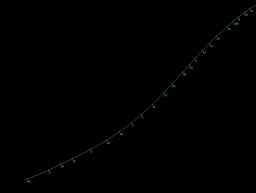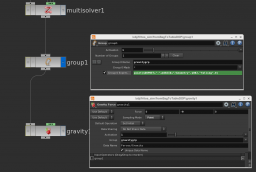-
Posts
96 -
Joined
-
Last visited
-
Days Won
4
mrWolf last won the day on June 21 2023
mrWolf had the most liked content!
About mrWolf
- Birthday 01/10/1972
Contact Methods
-
Website URL
www.alessandropepe.com
Personal Information
-
Name
Alessandro
-
Location
Bay Area
-
Interests
Squash, Food and Particles
Recent Profile Visitors
The recent visitors block is disabled and is not being shown to other users.
mrWolf's Achievements
-
mrWolf started following How would you create this kind of snow accumulation?
-

How would you create this kind of snow accumulation?
mrWolf replied to ploytv's topic in General Houdini Questions
Really cool application Ploytv ! I'm glad the article gave you some good inspiration -
Thank you man , I'm glad somebody actually reads that gibberish !! The more I play with your setup , the more I like it. I tried to duplicate the sphere source and move it like 1000 units away...and yes, the sim gets a bit slower, but being used to see how slow non-sparse volume grid based sims can get, it's quite an amazing feeling. Plus one thing I love about this setup is that it's incredibly simple. I've to create a dust trail setup, mmm I think I'm going to give this technique a try. *OpenVDB creators, please please please make a OpenCL version of VDB advect and VDB project non divergent nodes*
-
Thank you for sharing this setup ! Yeah it feels like the DOP's smoke is faster when it comes to single emitter like in your example, but if you have multiple emitters distributed in space, I bet this setup wins in terms of speed and memory footprint. I really hope they'll make VDB project non divergent faster , possibly GPU based ... see Eddy for Nuke for instance ( sparse grid + GPU = love )
-

LA-HUG Meetup: Ink Underwater and Tornado FX with Alessandro Pepe
mrWolf replied to pclaes's topic in Lounge/General chat
hey Horizon, no, I didn't use any sss. I worked in comp to achieve a satisfactory result. Something that really helps with smoke is finding the right density value. High density can give you great details, reduces render times (cause the ray tracer has to travel less samples before accumulating the full opacity), shadows really dark, smoke very thick and dirty and not a lot of transparency (like in your render). I would recommend playing with density values in the volume procedural shader and in the material shader too. On top of that, play with the ramp associated with the material shader, that changes a lot the look of the smoke too. I hope this helps. -

LA-HUG Meetup: Ink Underwater and Tornado FX with Alessandro Pepe
mrWolf replied to pclaes's topic in Lounge/General chat
hi Horizon ! The hip files included are supposed to present a technique more than matching a specific look and they are a simplified version of the setup I created to achieve those effects in production. The purpose of the presentation was to inspire and trigger the desire to learn more. It's up to you to tweak parameters , use bits and pieces in your setup or maybe re-create the setup from scratch to understand the details and maybe come up with your own flavor. If you've a specific question about technical details in the setup please let me know and I'll definitely try to help. -
jasonlovevfx started following mrWolf
-

LA-HUG Meetup: Ink Underwater and Tornado FX with Alessandro Pepe
mrWolf replied to pclaes's topic in Lounge/General chat
hey Ben ! the presentation was recorded by Framestore. It is being edited in these days and hopefully it'll be ready soon. I'll get you in touch with who's dealing with this so you'll be the first person to know. -

LA-HUG Meetup: Ink Underwater and Tornado FX with Alessandro Pepe
mrWolf replied to pclaes's topic in Lounge/General chat
Hey Peter, it was just a bash script containing one mplay command reading more than one sequence, and with -V option to create specific row / column layout so I could visualize more than one file sequence per time. Example: mplay -V 2 2 -g flipbooks/03_tenPoints/* flipbooks/04_thousandPoints/* flipbooks/05_millionPoints/* .. this line will open mplay with a 2x2 row-column layout (in total 4, but since I'm specifying only 3 image sequences, the 4th spot in the lower right corner will be ignored) and 3 file sequences. The -g option " ... groups the command line images into separate sequences, based on base name and extension". An option that I use a lot is the option -C. This will pre-cache all the files before opening the actual player view, so that when the viewer finally shows up, the play is in real time. I didn't use this one during the presentation cause I thought it's less boring to watch the frames pre-caching opposed to a progress bar slowly reaching 100% The reason cause I was using the syntax "bash ... script.sh" was because I was storing the presentation on an FAT formatted HD, which doesn't allow to chmod +x to flag the script as executable, so I had to run a bash shell and the script as a parameter. p.s. mplay is awesome , pity it doesn't play videos -

LA-HUG Meetup: Ink Underwater and Tornado FX with Alessandro Pepe
mrWolf replied to pclaes's topic in Lounge/General chat
Thank you ! Here it is the zip file including PDF and all the hip files with the ink setup and tornado setup. The scene files have been created with Houdini 15.5.632. Enjoy ! Hug_Nov2016-AlessandroPepe.zip- 15 replies
-
- 15
-

-

LA-HUG Meetup: Ink Underwater and Tornado FX with Alessandro Pepe
mrWolf replied to pclaes's topic in Lounge/General chat
Peter thank you for posting this ! I really enjoyed talking with you all yesterday , the vibe was really good and despite the length of the presentation (2.5 hrs ! luckily we had beer :D) I got really good feedback. I was totally not expecting such a response and I'm happy there is such an alive, vibrant and apparently growing Houdini community in L.A. Thank you all for attending ! @Eetu : totally ! I'll get the pdf and hip files ready in a nice zip file and post it tonight in this thread. -

Inline Code - Implicit cast from float to int
mrWolf replied to j00ey's topic in General Houdini Questions
hey j00ey, is it possible that you defined $mp as a float ? If so, that might be the issue. Try to define $mp as an int. p.s. did I just reply a 2 yo post ? lol -
Works flawlessly. Thank you Tomas !
-
Is there any sop node to convert an open polyline into *one* NURBS curve ? This is the poly object I am starting from : Each segment, forming the polyline, is an open polyline that connects two points. There are no overlapping points. The topology is very clean and it contains all the info required to rebuild a NURBS but I cannot find any SOP node that achieves this. I tried "Convert" sop , forcing the conversion to NURBS curve, but of course it creates a ton of tiny NURBS curves , each one matching the original segment. I am sure I am missing something very obvious
-
hi Pradeep, thank you for the example hip file, very much appreciated. Your explanation makes sense and it works great ! I was trying to stay in the rbd land and use the old style way to drive rbd objects. But I guess with rbd packed primitives , since we deal with points and transformation matrices opposed to real geometry, we are suddenly in a pop world instead ! I've read often here and there that it's possible to access the real geometry of a rbd packed primitive in a sop solver (meaning, unpack ... use and re-pack), but I wasn't able to accomplish this. Meaning that when I re-pack the element it's not the same as the one I unpacked (primintrinsic are lost when unpacking), so the sim breaks. Is there a proper way to actually extract the packed data , within DOP, use it, and repack it seamlessly ?
-
I have a RBD sim, with 1 packed object which contains 9 elements. I am trying to disable the gravity only on certain elements, within the packed object. In order to achieve this, I would like to control the gravity node with a dop group. I created a point attribute "falling" which I control in a sop solver, within the dop network. Then I created a DOP Group that creates a group based on the following expression: point($DOPNET+":"+$OBJID+"/Geometry",$OBJ,"falling",0) Now, this seems to work but ...not quite. I see elements that start fluctuating at a certain moment, but this moment doesn't match the moment when the "falling" attribute is triggered to 0. To start, I'd like to understand if I am using the above expression correctly. I am quite confused with the global variables $OBJID , $OBJ used with Packed Objects. Could anyone shed some light on this? I am on H13.0.547





